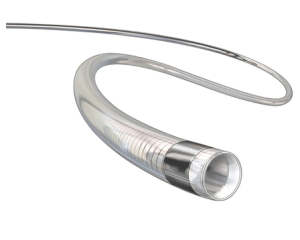
A study of the long-term use of the ADAPT technique for the treatment of acute ischaemic stroke has confirmed that it is an efficient method to achieve good clinical and angiographic outcomes, with 82.2% of patients achieving TICI 2C or better recanalisation and 90-day mRS scores of 0–2 in 54.4%.
Jan Vargas (Medical University of South Carolina, Charleston, USA) and colleagues sought to report their centre’s ongoing experience with the ADAPT technique, which has been used as the primary revascularisation technique at that institution since 2012.
A retrospective analysis of a prospectively maintained database was performed to identify all patients undergoing thrombectomy for large vessel occlusion with ADAPT at that institution using an institutional review board approved protocol. Patients undergoing thrombectomy between December 2012 and April 2015 were included. Specific parameters captured included age, gender, National Institutes of Health Stroke Scale (NIHSS) score at presentation, and time to presentation from last normal. Of significance, angiograms were blindly graded by an independent neurointerventionalist to assess pre- and post-revascularisation using both the Thrombolysis in Cerebral Ischaemia (TICI; with scores of 0, 1, 2A, 2B, and 3) flow post procedure and the modified 2C TICI grading scale (including scores of 0, 1, 2A, 2B, 2C, and 3).
According to the data, from December 2012 to June 2015, 191 consecutive patients who suffered an acute ischaemic stroke were treated with ADAPT by four operators. Ninety-one patients were women (47.6%), and the average age was 67 (range 27–93 years, ±14 years). A total of 171 (89.5%) ischaemic strokes occurred in the anterior circulation and 20 (10.5%) in the posterior circulation. Patients presented with a mean NIHSS score of 15.4 (range 0–36, ±7), and 71 (37.2%) patients received IV t-PA. The average time from onset to puncture was 7.8 hours (range 20min to >36 hours, ±6.1 hours). Twenty-three patients (12%) presented as wake up strokes. The average length of stay was 9.3 days (range 0–193, ±16.9 days). Twelve (6.3%) patients had tandem lesions noted during treatment. In 10 cases, the occlusion was in the internal carotid artery, with tandem distal lesions in ipsilateral branches of the middle cerebral artery. There were no cases of emboli to new territory following aspiration thrombectomy. In two cases of basilar artery occlusion, the patients had additional occlusion of left sided middle cerebral artery branches, one of which was felt to be a chronic thrombus and was not aspirated.
The authors report, “The average time for recanalisation was 37.3min (range 7–160min, ±29.6) across all cases. There were no differences among operators. Independent adjudicated angiographic outcomes of TICI 2B or better recanalisation was achieved in 180 (94.2%) patients, TICI 2C or better was achieved in 157 (82.2%) patients, and TICI 3 was achieved in 85 patients (44.5%). Recanalisation was unsuccessful in two cases. In one patient who suffered a basilar occlusion from extensive atherosclerotic plaque, recanalisation was not achieved (TICI 0) due to abortion of the procedure secondary to intraprocedural basilar artery rupture. In a second patient, multiple attempts were made to recanalise a completely occluded right internal carotid artery, ultimately resulting in partial revascularisation. The ACE 64 catheter (Penumbra) was used in seven cases, all of which achieved a TICI score of 2C or better (100%). The 5 MAX ACE (Penumbra) was used in 101 cases, of whom 78 (77.2%) achieved TICI 2C or better. The 5 MAX catheter (Penumbra) was used in 33 cases, of whom 30 (90.2%) achieved TICI 2C or better. The likelihood of achieving TICI 2C or better recanalisation was not significant for the ACE 64 (p=0.35), 5 MAX ACE (p=0.087), or 5 MAX (p=0.21) catheters.”
As it relates to complications, they write that there were four intraprocedural complications. Further, 13 (6.8%) patients suffered clinically significant post-procedural parenchymal haematomas; one patient (0.57%) had a retroperitoneal haematoma; and seven patients (3.7%) suffered post-procedural gastrointestinal bleeds.
In terms of outcome, Vargas et al report that the average time from onset to puncture was 7.8 hours and the average time for recanalisation was 37.3min. TICI 2B or better recanalisation was achieved in 180 (94.2%) patients. Ninety-eight patients (54.1%) had an mRS of 0–2 at 90 days.
Of note, ADAPT was successful in achieving final recanalisation in 145 of cases, and 43 cases required the additional use of a stent retriever. Eight direct aspiration only cases had lesions in more than one vessel, compared with four in the direct aspiration with adjunctive devices. In two cases, recanalisation was not achieved. Additionally, the authors highlight, “Mean time to recanalisation was significantly faster for direct aspiration only cases, with revascularisation achieved in 30.12min (range 7–150min, ±29.56) compared with 61.4min (range 8–160min, ±35.85) (p=0.00000201). There were no significant differences in likelihood of achieving a 90-day mRS of 0–2 (57.7% for direct aspiration only vs. 43.2%; p=0.12) or mortality rates among the two groups (13.9% for direct aspiration only vs. 18.2%; p=0.47).”
Vargas et al conclude that in their long-term experience, “ADAPT is an efficient method to achieve good clinical and angiographic outcomes, with 82.2% of patients achieving TICI 2C or better recanalisation and 90-day mRS scores of 0–2 in 54.4%. These results are comparable with recent randomized trials that demonstrate the benefit of intra-arterial thrombectomy.” They add that ADAPT as a first line strategy for achieving revascularisation in the setting of acute large vessel occlusion should be further studied in a randomised trial.











